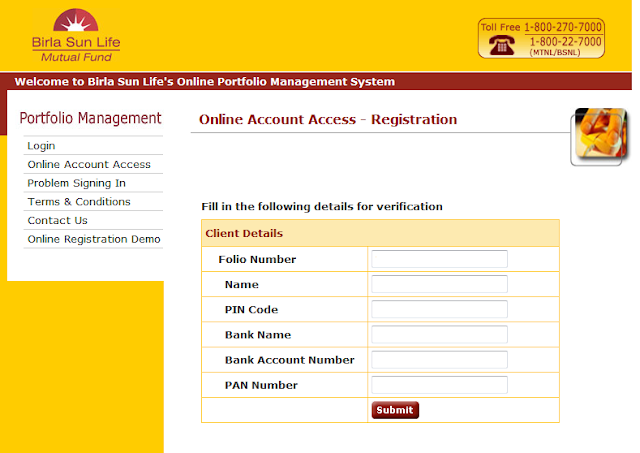Dematerialization of Mutual Fund Units means holding mutual fund units
in demat form. SEBI now allowed mutual fund investments to be held in
dematerialized form.
It means that investors will have the option to
convert their existing mutual fund investments into dematerialized form
and buy/sell units through stock exchanges.
How to convert mutual fund units in demat Form:
1. Obtain Conversion Request Form (CRF) from your DP.
2. Fill-up the Conversion Request Form (CRF).
3. Submit the CRF along with the Statement of Account to your DP.
4. After due verification, the DP would send the CRF and Statement of Account
to the AMC / RTA.
5. The AMC / RTA after due verification will confirm the conversion request
and the Mutual Fund Units in your demat account will be credited.
Important points to remember at the time of filling Conversion Request Form (CRF)
1. It is mandatory to mention the ISIN* (International Securities Identification Number) of the Mutual Fund schemes while filling up the CRF
Now what is ISIN Number?
ISIN mean International Security Identification Number. ISIN is a unique 12 digit alpha-numeric identification number allotted to the Mutual Fund Scheme. Each scheme will have an unique ISIN. It can be obtained from
amfi India.com, NSDL or CSDL and has to be included in the CRF/DRF.
2. Submit Separate CRF for each folio number.
3. If mutual fund units are in locked-in and free under the same ISIN, in such case You will be required to submit a separate CRF for locked-in and free units if
such Mutual Fund Units (represented by Statement of Account) are held under
the same ISIN.
4. The name and pattern of the holding must be same in demat account and Statement of Account.
If the name and pattern of holding in your demat account is different from the name and pattern held in Statement of Account, Mutual Fund Units cannot be converted into dematerialised form as there is a mismatch in the pattern of holding.
5. Nominee Details: The nomination present in a demat account will also be applicable for Mutual Fund Units held in that demat account. If you so desire, you can change the nominee in your demat account by simply filling-up the nomination form once again and submit it to your DP or open another demat account to nominate the desired person as a nominee in that demat account.
How to Purchase and sale after mutual fund units converted in demat form
Purchase
You can subscribe for mutual fund units through
your Stock Broker using the Stock Exchange platform. Upon subscription,
your Stock Broker i.e., Clearing Member will credit the Mutual Fund
Units into your demat account.
Sale
You can redeem your mutual fund units held in dematerialised form
through two different modes i.e., through your DP or stock broker.
1. If redemption is through your DP
- Obtain Redemption Form (RF) from your DP.
- Fill-up the RF form and submit it to your DP.
- After due verification, your DP will execute electronic redemption request, which will be electronically forwarded to the AMC / RTA
- The AMC / RTA will verify the redemption request and if in order, confirm the electronic request and make the payment as per your bank account details available in your demat account.
2. If redemption is through your stock broker
you
will have to submit delivery instruction slip (DIS) to your DP to
transfer the mutual fund units to a designated CM Pool account of
National Securities Clearing Corporation Limited
Advantages of Holding units in demat form
- You will receive single transaction statement from your DP, which will
display all the securities and Mutual Fund Units held in your demat account.
- You will get consolidated and updated portfolio view of all your holdings across stock and mutual funds and it makes monitoring various investments much easier.
- Single entity to be notified in case of change in details like change in bank details, address, or nomination details and
Disadvantages of Holding units in Demat Form
You need to keep in mind that this convenience comes with a cost.
This will result in paying additional cost for your mutual fund investment.
How
1. Demat Account Annual Maintenance charges
Opening a new demat account means additional cost in the form of annual
maintenance charges. These can vary from Rs 300-500 a year. You will
also need to open a trading account with a brokerage house.
2. Transaction Charges
This differ from DP to DP, The DP also levies a charge. Each time a security moves out of your
demat account, you need to pay a fixed charge of Rs 20 per transaction.















































.....png)







.....png)



